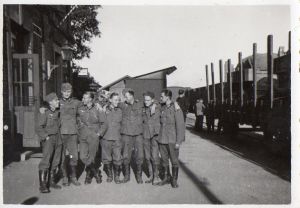Debica

Debica Railway Station with German Troops
Debica is a town in South Eastern Poland and during the Second World War was the location of a massive SS military training camp. About 1,500 Jews lived in Debica during the interwar period, representing approximately forty percent of this small-town’s population. Most earned their living from small-scale commerce, especially in the garment and food industries. They were aided by a trade and craft association, by a free-loan society supported by the Joint Distribution Committee (JDC), and by a Jewish bank. The JDC also assisted in organising training courses for artisans. Educational institutions in the community included a Talmud Torah, a Yeshiva, a Beit Yaakov school for girls, and a Tarbut Hebrew school in which cultural and Zionist activities were held; a Hebrew kindergarten also operated for some time. Debica had a drama circle and two sports clubs. Zionist parties and youth movements were active as were two libraries and a chapter of Agudath Israel.
After the Second World War broke out, a number of Jews fled from Debica to the area under Soviet control. The Germans occupied Debica on 8 September 1939 and immediately began to terrorise the local population, by plundering their property and to abduct people for forced labour. In November 1939, the Germans ordered the Jews to establish a Judenrat, which was headed by Tuvia Zuker. The Judenrat was charged with supplying Jews for forced labour and paying hefty fines and ransom payments. In the spring of 1940 the Germans conducted a census of the Jewish inhabitants to tighten supervision of forced labourers. In June 1940, Jewish men were seized and transferred to Pustkow, where they were employed building a labour camp, that was opened in November 1940 and active until 1944.
In the winter of 1940/41, the well-being of the Jewish community deteriorated significantly due to the restrictions on the Jews freedom of movement, the plunder of Jewish property and frequent monetary fines and demands. In late 1940 a public soup kitchen supported by the Jewish Social Self Help (JSS) was opened in Debica.Yosef Tob replaced Zuker as head of the Judenrat. In early 1941, the Germans started to concentrate the Jews in a separate quarter, and in early 1942, they established a closed ghetto in a part of the town. A permit was required to leave the ghetto, and Jews caught smuggling food or found outside the ghetto’s confines without a permit were executed. In the second half of June 1942, Jews from nearby localities were brought to Debica, raising the number of inhabitants incarcerated within the ghetto to approximately 4,000 people. In light of impending rumors about deportations, many Jews began to prepare hideouts. On 29 June 1942, SS and Polish police units encircled the ghetto and started to round-up the Jews.
Those with work permits and their families were allowed to remain in the ghetto, whilst some groups of men were sent to forced labour in Rzeszow, Mielec and Pustkow. About 200 Jews, were not so fortunate and were shot to death in Lisia Gora, near the village of Wolica, and approximately 2,000 were deported to the Belzec death camp. Jews found hiding or too ill to be deported were shot in the Jewish cemetery. After the June ‘Aktion’ many Jews who had managed to hide returned to the ghetto, and many paid money to obtain one of the jobs considered essential to the German war effort, in the hopes of avoiding deportation in the future. In late 1942, the Debica ghetto was assigned the status of a labour camp. In early 1943, Jews from nearby communities that had escaped extermination were brought to the Debica labour camp, raising the population to approximately 1,600. Some of those living in the camp illegally were caught and executed, while others managed to flee to the Bochnia ghetto, although it is likely these perished in Auschwitz death camp on 2 September 1943, in a transport of approximately 3,000 Jewish men, women and children. The labour camp was liquidated in April 1943 and the remaining prisoners were transferred to other labour camps in the Cracow area.
Sources:
The Yad Vashem Encylopiedia of the Ghettos During the Holocaust Volume 1, Yad Vashem, 2009.Y. Arad, Belzec, Sobibor, Treblinka – The Aktion Reinhard Death Camps, Indiana University Press, Bloomington and Indianapolis 1987
D.Czech, Auschwitz Chronicle, Henry Holt & Company, New York 1989.
Photograph – Chris Webb Archive
© Holocaust Historical Society 2014

